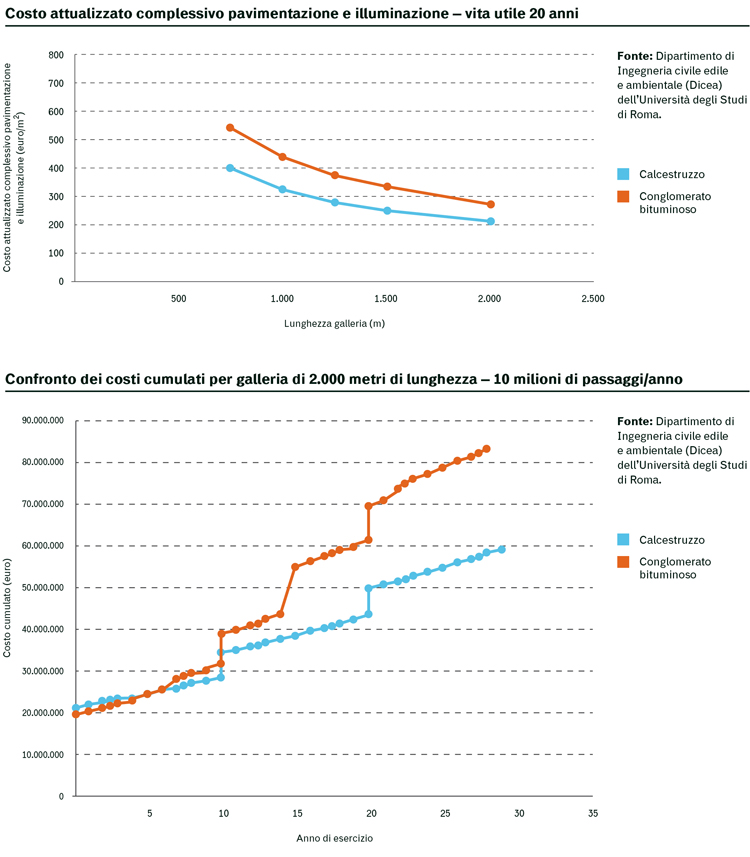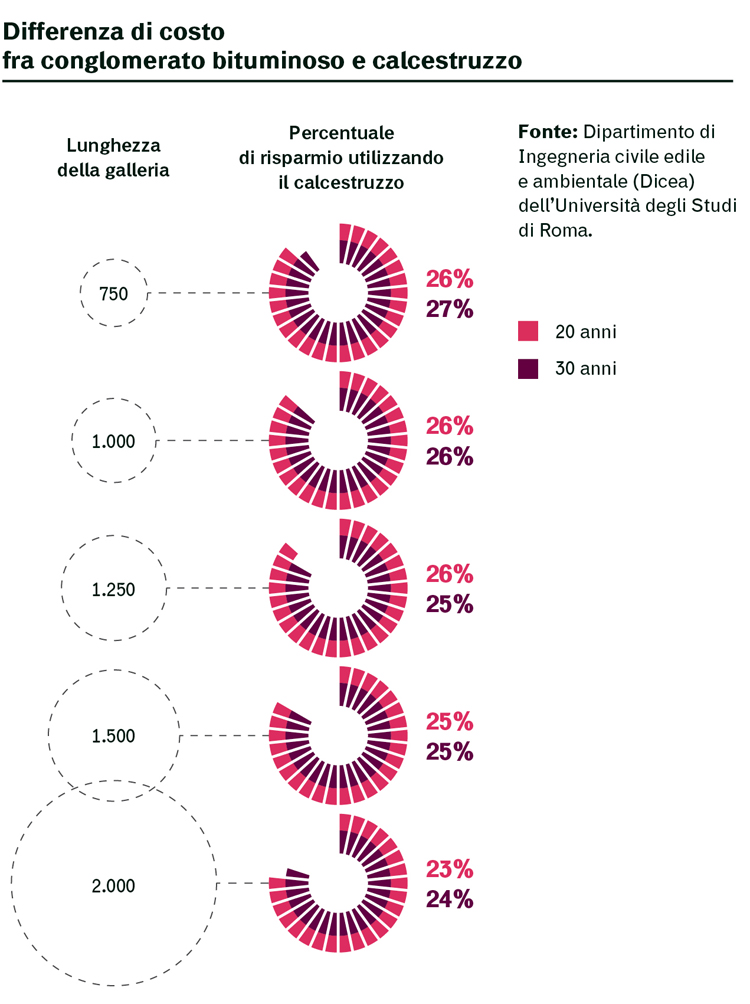It increases the safety of road tunnels in case of fire, it dramatically reduces energy consumption for lighting and has a considerably longer life expectancy compared to other materials used for road surfacing. Moreover, in a circular economy perspective, it is a locally-sourced material that, once it reaches its end of life, can be 100% recycled. There are many reasons to prefer concrete as a material for road tunnel surfacing over bitumen. This is already happening in many countries, but not in Italy. And if more evidence were needed, life cost analysis (LCA) is available, showing that the more costly asphalt paving saves considerable more money compared to bitumen in the long run.
“The use of concrete can guarantee 50-year durability in road tunnel paving. Such length of time can be extended with possible extraordinary maintenance”, explains Giuseppe Marchese from Federbeton, a confederate of the Italian Industrial Federation of the associations in the field of cement and concrete. “If the ordinary maintenance on a bitumen road is regularly carried out every year, with concrete it can be done every 10-15 years. This is because concrete is a much more compact material than bitumen from a chemical point of view, thus being more resistant to atmospheric agents and friction from tyres. Then, with extraordinary maintenance, at least 4-5 centimetres of the road surface can be eliminated for rebuilding: with bitumen this is necessary every 4-5 years, with concrete, every 50 years.”
Saving with colour
Concrete pavement is of a light colour, thus boasting a higher reflection coefficient compared to those in bitumen: 0.10 against 0.07. Therefore, drivers can spot more easily possible obstacles and perceive with a higher degree of precision the road size, which is crucial to enhance safety in a tunnel. Moreover, a higher reflexion coefficient entails less energy consumption for lighting.
In a study conducted by Università La Sapienza in Rome, dual carriageway tunnels with different lenghts (750 m, 1,000 m, 1,250 m and 1,500 m, 2,000 m) were taken into consideration. For each length and level of traffic, both concrete and bitumen have been tested; then a technical-economical analysis of the pavements and the LED lighting system (80,000 hours in total) have been analysed with reference to their whole life cycle, estimated from 20 to 30 years. They found out that in tunnels less than 750 m long, the formation expenses of the tunnel (road building and LED lighting system) were lower for the concrete paving. As the tunnels become longer, the economic advantage of concrete paving diminishes as far as the formation expenses are concerned, but the overall cost per square metre of concrete paving is lower compared to those in bitumen, regardless of the period of the analysis. Researchers have also worked out the break-even year, where concrete paving has an overall cost (building, maintenance and lighting) lower than the bitumen one. In galleries less than 750 m long, concrete proves cheaper already from the first year, while in those longer than 1,000 m they are cheaper only after a few years. Considering all costs for the entire life of the paving, a total saving between 23 and 27% is achieved, depending on the length of the tunnel and its useful life.
Paola Di Mascio, Professor of the Department of Civil, Constructional and Environmental Engineering at Università La Sapienza in Rome, reckons that “the study conducted together with Professoressa Laura Moretti (La Sapienza University –Civil Construction and Environmental Engineering) highlighted clear economic sustainability of concrete road tunnel paving. Indeed, compared to outdoor road paving, whose advantage only emerges in the medium-long term thanks to reduced maintenance, there is an economic advantage already in the total formation expenses of the paving and lighting system (in the case of LED), especially in the tunnels shorter than 1,200 m. Such economic advantage is even higher if maintenance costs within its useful life are taken into account.”
Why is Asphalt More Popular in Italy?
Considering the many advantages, one wonders why in Italy road tunnel paving is still carried out with asphalt rather than concrete. What’s more, Italy boasts the longest mileage of road tunnels within the Transeuropean road network (TERN).
“Firstly, it is for cultural reasons,” Marchese comments. “Historically, in Italy the building industry uses concrete. This applies to residential buildings (detached houses and blocks of flats), but also infrastructure. This building tradition where concrete is king is accompanied by an equally well-established habit of building roads with asphalt. The concrete tradition has been lost within the building sector and as a result today there no longer are operating companies in this field. In addition, companies often think short term when it comes to roads: they prefer to build them at a low cost with asphalt, envisaging maintenance on a yearly basis, rather than investing more heavily at the start while considering future savings for the community in the long term thanks to concrete building.”
Italian and European Regulations
Back in the early 2000s, the road accidents occurred in the Mont Blanc, the Tauerntunnel and the Gotthard Tunnels have pushed the European Union to improve the level of safety in tunnels. The European Commission introduced directive 2004/54/CE, establishing minimum safety requirements for TERN galleries, without imposing the use of one particular material over another. Such directive has been harmonized in Italy with Dlgs 264/2006, which, contrary to what happened in other European countries (Austria, Germany, Slovakia, Slovenia and Spain), has not specific road paving characteristics to adopt. The above-mentioned countries have passed regulations and guidelines including indications regarding road tunnel paving and requirements for the most suitable materials. Regulations in such countries, therefore, always mandate the use of concrete for road tunnel pavements. The German law is an exception, it does not mandate the specific use of concrete, but rather the use of non inflammable material, which, in case of fire does not release toxic fumes. Such characteristics are 100% met by concrete – an inert and non-combustible material – which does not release toxic fumes and keeps its structural performance even at high temperatures. The latter guarantees enhanced safety thanks to the fact that the road surface is not deformed.
Less Maintenance
Moreover, concrete road building fits in perfectly with the circular economy’s philosophy, adds Giuseppe Marchese. “First, because such roads are locally sourced, because concrete is by nature a local material and contributes to the development of the local economy. Second, when the road reaches the end of its life, its material can be 100% recovered to make recycled inert materials to be used for road subbase, filling or to make new concrete. It is essential, though, to plan from the start an adequate solution with concrete: every tunnel and traffic situation has its own peculiarities. The same is true in the building sector: a concrete building which is meant to stay in sea water for a long time must guarantee a different performance compared to another one built high up in the mountains.”
Thinking of replacing existing bitumen roads with cocrete ones is slightly more challenging, in that generally speaking, in Italy, services (for example the gas or water networks) are situated below street level rather than on the side, so concrete paving would entail very challenging work. “Apart form these situations, we could use concrete virtually everywhere,” explains Giuseppe Marchese. “If all galleries, road junctions and roads leading to toll booths were made of concrete, where the road surface udergoes particular stress due to traffic, the community would save a lot of money. Then, I believe that concrete not only would be advantageous but indispensible in road tunnels over a kilometre long for safety reasons and for the savings in street lighting.”

“From a more general point of view, the use of concrete eliminates social costs, not included in the technical-economical assessments, linked to inconvenience and risks for the ever-present maintenance works for the road surface and for the visibility conditions” states Giuseppe Mancini, full professor at the Department of Structural, Construction and Geotechnical Engineering at the Polytechnic University of Milan. “Moreover, the cultural delay Italy is experiencing with regard to the use of concrete in road tunnels stems from a more general socio-cultural backwardness in the extraordinary evolution of ‘concrete’ as a material over the last twenty years. Nowadays, in Italy and the world over, the so called tailor-made concrete is produced, able to accommodate all performing requirements an architect may have in mind, thus allowing the building of durable and high-performing road surfaces that can withstand any accidents that may occur during their lifetime.”

The Road Chosen in Laives
In December 2013, the Laives Tunnel, 2,858 m, the longest in the autonomous province of Bolzano, was opened to the public.
It is a single carriageway two-way tunnel, with a 3.75 lane running in each direction, built according to the criteria of the “Functional and geometrical regulations for road planning and building” enacted by the province of Bolzano in 2006. Since according to such regulations it is classified as Class A, the client and architects decided to replace the bituminous conglomerate paving of the original project with a concrete one. Therefore, taking into consideration the Austrian law (since the Italin one does not cover concrete), non-reinforced 20 cm wide concrete slabs have been used, laid on a 5 cm bituminous conglomerate separating layer put over a 30 cm subbase. The cost to build such paving, including the separating bituminous layer and the making of all joints, was of €58 per square metre, with 25% estimated savings in lighting. The increase in cost to build such work was only 0,7%.
Federbeton, www.federbeton.it


